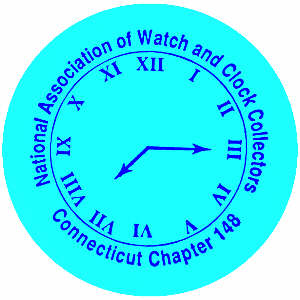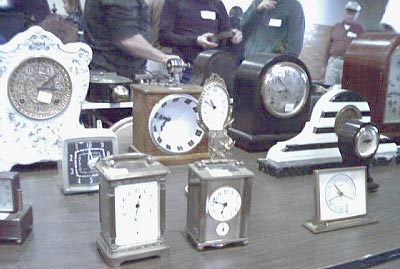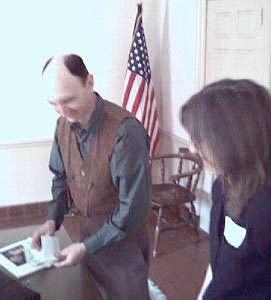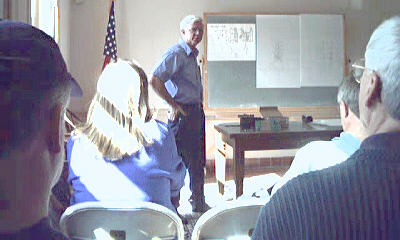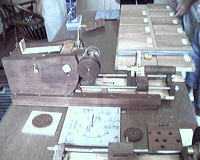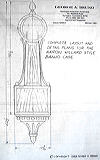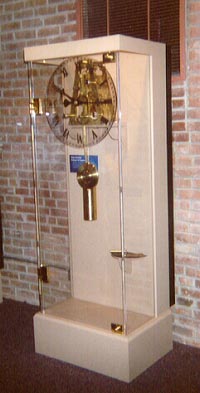Meetings PastMeeting Highlights - November 17, 2001 The chapter's well-attended November meeting (its last meeting scheduled for 2001) took place on Saturday, 11/17. All available mart tables were occupied, much to members' enjoyment.
Special thanks is due to Phoebe Katzin for contributing much time in planning, organizing and mailing essential to the success of chapter activities during the past and previous years. These are not small tasks! For those of you who haven't met Phoebe, she is most easily recognizable as the presence behind the check-in table at every meeting. We very much appreciate her efforts in ensuring chapter events and meetings run smoothly! While we're at it, thanks is also due to Jim Katzin for the excellent job he has been doing as chapter president. Jim is without question our chapter's motivating force. For those of you who don't know Jim, he is thoughtful, humble, and generous of his time and ideas. A strong advocate of quality educational activities and research, his energy and ability to bring people together are legendary. We are fortunate to have such an extraordinary individual at the helm!
Briefly, prior to the mid-eighteenth century, English watches essentially made in one shop were luxuries generally affordable only to royalty. Timekeeping qualities were poor. However, what early watches lacked in timekeeping accuracy they made up for in ornamentation. Many were lavishly decorated with jewels and porcelain. Some sported impressive repeater, calendar, and music box mechanisms. Early manufactured verge fusee watches tend to be bulbous in overall appearance attributable to technical difficulties inherent in producing a relatively slender fusee mechanism. Notwithstanding many different types of escapements invented during the 18th and early 19th centuries, the English industry generally failed to respond to technological advancements. Consequently, verge fusees predominated until the late 19th century. Rob reports having owned one made as recently as 1925. At least twenty-one different rural or cottage industries are known to have contributed to the finished product sold by the "watchmaker". These industries were engaged in activities including but not limited to engraving, pillar-making, gilding and chainmaking operations. Adolescent girls were employed in piercing and engraving the elaborate balance cocks of early watches. By the mid 19th century, the English watchmaking industry was in sharp decline. Imports exceeded exports by this time. Features useful in dating English verge fusee watches include gradual disappearance of the pair case during the early 1800's, coinciding with the appearance of dust covers. Dust covers became more numerous as the 19th century progressed. Single case movements are hinged and swing outward. Most English watches wind through the back, while European watches and possibly those made for the European market wind through the dials. English dials almost invariably have Roman numerals. When evaluating a watch for purchase, pair cases should bear the same maker's stamp. In general, it is desirable that dials show minimal wear. Because the fusee balance staff is difficult to replace, it is important to note whether the two paddles move when the watch is rotated. However, it is reasonable to lower expectations as to acceptable condition when considering a relatively early watch. We would like to thank Rob again for sharing his extensive knowledge. We appreciate his dedication, and that of fellow collectors through whose courage and perseverance much important information and artifacts are preserved. --Mary Jane Dapkus * * *Meeting Highlights - September 15, 2001 Chapter 148 met on Saturday, September 15, following what was surely the most somber week in recent history. Chapter president Jim Katzin initiated a moment of silent reflection in light of our recent national tragedy. Members joined to honor those killed, and to hope for the success of rescue, recovery and related efforts. As might be imagined, our conversations could not help but turn to matters of gravest concern over mart tables that morning. Our guest speaker was member and Waterbury, CT resident Bill Curley. In anticipation of its 2001 opening, the Timexpo Museum of Waterbury had searched for a qualified individual to build a large scale brass movement for demonstration and exhibition purposes. The Museum ultimately located and selected Bill, a highly skilled and experienced manufacturing tool engineer and clock repairer specializing in making custom replacement parts, to receive the commission. His talk detailed the ensuing technical challenges involved in this unconventional project.
Bill Curley addressing the members in the meeting room of the Edmond Town Hall Bill began work from the museum's proposed concept drawing based on a two-weight Waterbury clock. The result was a skeletonized, single weight, straight line train (time only) design. With the assistance of computer aided design (CAD) programming, Bill scaled the resulting drawing upward by 2.5 times. Next, he designed and built custom gear cutters to produce the oversized teeth. He made other custom tools to complete the project, and virtually all parts of the movement, including wheels, screws and arbor shafts. Bill described advanced technologies used in several aspects of the project including pinion cutting. Even so, much hand finish work was required. Bill used an outside source to machine the enlarged plates and dial blank. These could not be done using conventional sized tools. NAWCC member Frank Machera was the dial artist. Since there was virtually no precedent for the project, there were a few surprises. Bill passed some examples around, including a lantern type third arbor pinion which was ultimately replaced by a solid one. Members enjoyed Bill's descriptions of his approach and solutions to the many problems which were bound to and did arise, such as how to design and make the weight, hands, and pendulum bob and how to figure out what to use for winding cord. The project took one year of part time work to complete. What a great story and a wonderful accomplishment! See picture of Curley's clock below. --Mary Jane Dapkus * * *Meeting Highlights - July 21, 2001 The July meeting of Chapter 148 was held on Saturday, July 21. The meeting featured mart, raffles, silent auction and speaker. Our guest speaker was chapter member and Torrington, CT native, George Bruno. George is so widely known throughout the NAWCC and beyond for his contributions to present-day understanding of eighteenth and nineteenth century wooden movement clockmaking techniques, the excellence of his work, the many articles he has written which have appeared in various horological journals and publications, and his expertise as a wooden movement clockmaker, that any introduction here seems unnecessary. However, for those who have never had the opportunity to meet him, George is also known for his stories, many of which will not be repeated here for fear of losing a certain quality in transcription. Let it suffice to say that one can learn a lot about a lot of things from George! George's presentation focused on the subject of a video taped "live" at the Eastern States Regional in 1998. In the film, George illustrates the evolution of wooden movement manufacturing technology culminating in Eli Terry's Porter contract movement ca. 1806. The Porter contract was the first known successfully completed mass production project in the United States. Earlier in the day, George explained that his clockmaking career began in 1966. Employed in manufacturing at the time, he was approached by a prominent collector. The man requested George's assistance in making castings for a wagon spring movement. The completion of this project marked a major change in George's life. As he relates it, scrap gears from failed experiments provided fuel to heat his family's home throughout the following winter. No doubt a key consideration for both George and Eli Terry was minimizing costs. The extensive array of tools and equipment presented in the video was essentially reinvented and handmade by George based on his research and discoveries. The collection represents tools, techniques and equipment which have generally not survived until the present but which were likely to have been used to complete the Porter contract. Gear teeth may be cut in a variety of ways. George discovered that during Porter contract movement production, gear tooth crowns were cut in a separate step, after the leading and trailing edges of the teeth were cut. Evidence was provided by a Porter contract movement which happened to be brought into the shop for repair. Upon examination, the cause of the problem was a gear with one tooth much longer than the others. Having either been skipped or not cut completely through, the faulty gear provided evidence that an integral cutter operating on both leading and trailing edges of the teeth simultaneously with the crown must have been a later invention, and could not have been used in making the Porter contract movements. Because, as he says, it looked so crude, George initially doubted the appropriateness of the machine he designed for filing escape wheels six at a time--until NAWCC member Ward Francillon discovered a similar machine that was more than two hundred years old. Next, after making and experimenting with a treadle-operated lathe, George concluded that pinions of comparable quality and quantity could not have been cut using such a lathe for the purpose of the contract. The video provides a step-by-step demonstration of likely Porter contract pinion manufacturing, beginning with preparation of the raw material, laurel wood. To accomplish the task of cutting pinions, George designed a machine which utilizes a pair of face keys driven by the mechanism, a hand-held maul, and snap gages to mark the thickness of the various sections as the pinion is turned. As a final step, he explained how to make the necessary tool with which to burnish the pinions. As an example of George's drawing, some of the information provided in the video may be found in Chapter II of the 2nd edition of the book entitled Eli Terry and the Connecticut Shelf Clock by Kenneth D. Roberts and Snowden Taylor (Ken Roberts Publishing Co., Fitzwilliam, NH, 1994). A wide range of plans and drawings may be obtained directly from George at the mart. The Porter Contract video featuring George is not available through the NAWCC Lending Library (although George's 1993 video on Terry's outside escapement movements is available through the Library.) Copies may be obtained through the NAWCC Syracuse Chapter. Follow up on Jeff Wood's May 19th presentation: Charles Warner's movement patented May 24, 1887 did overcome the problem of lightening-induced current in the coils of secondary clocks which caused hands on secondaries to advance asynchronously with respect to the master clocks. This development ensured the continued survival of Warner's company, Standard Electric, in what was then a tumultuous market. The need for automatic resetting arose from continued problems with "scatter" among secondaries attributable to factors including but not limited to weak batteries and dirty or maladjusted contacts. Furthermore, as remotely generated power replaced batteries, it was necessary to bring systems back on time after power outages such as those caused by storms. In 1923, International Business Machines (IBM) invented a mechanism for spring driven master/slave clocks. In an effort to compete, Standard Electric introduced its own corrective system in 1929. According to Jeff, Standard Electric's resetting system was significantly different from IBM's. However, IBM promptly sued arguing patent infringement. In 1932 Standard Electric introduced the gravity resetting system as a means of avoiding patent infringement issues. This system also had the advantage of eliminating electrical contacts and associated problems with the secondaries. The resetting system allowed secondaries to be corrected hourly for errors extending up to 25 minutes fast or slow. Because the secondary movements essentially operate 1/60th as frequently as spring driven movements, it is important not to oil the movements of the secondaries to avoid friction problems attributable to old oil solidifying over time. Without oiling, secondary clocks proved to be capable of running forty years or more without attention. However, replacing worn pawl rivets may potentially extend the movement's life by a comparable amount. --Mary Jane Dapkus * * *Meeting Highlights - May 19, 2001
|
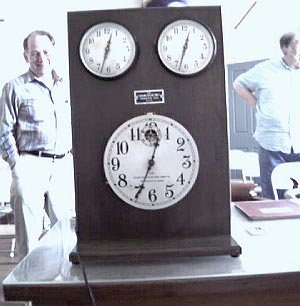 Jeff illustrated his talk by means of an unusual salesman's model AR3 Standard Electric clock dating to Ca. 1932. This artifact contained a standard master clock movement (with a shortened pendulum to speed up operation for demonstration purposes) adjoining a pair of slave clocks in a portable case. |
Our speaker was Jeff Wood of Wilbraham, MA, independent scholar, consultant and authority on the history and operation of Standard Electric Time Company clocks. As the reader may recall, Jeff's assistance to the chapter's recent restoration of the Edmond Town Hall's Standard Electric tower clock was critical to the project's success. Jeff produced not only appropriate secondary movements to replace several that had long been missing, but also, miraculously, the original wiring diagram for the Edmond Town Hall! Jeff explained that prior to the adoption of an alternating current standard, electric timekeepers were driven from direct current. Motor speed varied with voltage. Early master clocks were essentially weight-driven regulators. The idea of winding a master clock electrically and sending impulses to secondary clocks originated with Chester Pond of the Time Telegraph Company of NY in the early 1880's. Charles Warner, a watchmaker and jeweler from Ansonia, CT was able to secure the rights to key patents. Warner was Standard Electric's founder. |
As illustrated by an ad placed in an 1886 issue of Electrical World, time was initially transmitted electrically from a "central station unit" via impulses over wire to remote secondary clocks connected in series. Warner rented wire space on poles shared with masses of telegraph, telephone and trolley wires. Problems ensued during thunder storms when lightening induced current in the coils of the remote secondary clocks, causing the hands on the secondaries to advance asynchronously with respect to the central or master clock. Charles Warner's electrically powered movement patented May 24, 1887, overcame this problem, ensuring the continued survival of his company in what was then a highly competitive market.
The need for automatic resetting arose from continued problems with "scatter" among secondaries attributable to factors including but not limited to weak batteries and dirty or maladjusted contacts. Furthermore, as remotely generated power replaced batteries, it was necessary to bring systems back on time after power outages.
In 1923, the International Time Recorder Company (later International Business Machines (IBM)) introduced an automatic correcting mechanism for its slave clocks. In an effort to compete, Standard Electric introduced its own corrective system in 1929. According to Jeff, Standard Electric's resetting system was significantly different from IBM's. However, IBM promptly sued arguing patent infringement.
In 1932 Standard Electric introduced a gravity resetting system as a means of avoiding patent infringement issues. This system also had the advantage of eliminating electrical contacts and associated problems with the secondaries. The resetting system allowed secondaries to be corrected hourly for errors extending up to 25 minutes fast or slow.
Because the secondary movements are in motion only for a fraction of a second during each minute, lubrication for these movements is less critical than it is with conventional clocks. The secondary clocks proved capable of running forty years or more without oiling. However, replacing worn pawl rivets as needed can extend the movement's life by a comparable amount.
In addition to 19th century newspaper and magazine articles and ads, Jeff illustrated his talk on the Standard Electric Time Company's history and technological contributions by means of an unusual salesman's model AR3 Standard Electric clock dating to ca. 1932. This artifact contained a standard master clock movement (with a shortened pendulum to speed up operation for demonstration purposes) adjoining a pair of slave clocks in a portable case.
Jeff provided a receptive audience with much invaluable information regarding restoration issues confronting the collector of early Standard Electric equipment. Furthermore, Jeff shared many unique experiences and discoveries in furtherance of the knowledge of Standard Electric history and technology.
Jeff is the author of several articles and has reprinted catalogs and other materials related to Standard Electric. We would like to thank him again for his dedication and his efforts in adding to our appreciation of this complex and fascinating subject.
--Mary Jane Dapkus
* * *
Timexpo Highlights - May 12, 2001
by Mary Jane Dapkus
On May 12, 2001, Chapter 148 joined Chapters 2 (New York) and 84 (Mid-Hudson) to host Timexpo 2001, a celebration of the opening of the Timexpo Museum in Waterbury, CT. The day's program began with a celebratory mart held at nearby Waterbury Armory and included presentations by renowned horologists, historians and collectors; live clock repair demonstrations; and backstage tours of the museum.
Objects spotted at the mart include: a verge fusee watch made by Thomas Bruton, London, c. 1778-1811; a pair of English verge fusee watches made by George Prior ca. 1793-1830 for the Turkish market: one triple-case with tortoise shell outer case, and one pair-case in silver plate; an early timeclock made by the International Time Recording Company, Endicott, NY; a Starke #1 lathe, c. 1865, complete with 120 4.7 mm collets and accessories; a collection of steeple clocks, including fusee and brass spring movement types as well as an example of the steeple-on-steeple case style; and a wonderful collection of wristwatches from the 1930's and '40's.
The day's presenters included Dana Blackwell, whose personal recollections of conversations with Archibald Bannatyne, the inventor of the dollar watch, formed the basis for his talk. Dana is a Chapter 148 member who served for many years as engineer-in-chief and vice president of the E. Howard Clock Company. To name but a few of his many additional offices and accomplishments, Dana also served as curator, horological consultant and president of the American Watch and Clock Museum in Bristol, CT, and presently serves as an honorary member of the museum's board of directors. Through Dana's warmth and experience, we were afforded an unusual opportunity to connect with Connecticut clockmaking history.
George Collard III, a professional dealer and longtime historian and collector specializing in clocks, watches, steam engines and scientific instruments, spoke on mechanical innovations in clock and watch manufacturing technology. Illustrated by a historically important collection of photographs as slides, George literally escorted his audience on a walking tour of the shop floors of the Waltham Watch Factory as it appeared in 1892. George delighted his audience with detailed knowledge of technical aspects of the plant's machinery and facilities.
Joe Ramos, a civil servant from New York City, addressed members on the subject of the history, appreciation and evaluation of character watches. Joe generously shared much valuable information gleaned from 25 years of collecting these fascinating objects. We were grateful to have the opportunity to share in his knowledge and enthusiasm.
The Timexpo Museum is located in Brass Mill Center and Commons in Waterbury, Connecticut. It is easily accessible from Interstate 84. The museum is well worth a visit to explore the evolution of Waterbury clock and watchmaking firms from the mid-nineteenth century to the present day, and to learn about the innovative minds that propelled the industry forward. The museum displays fine collections of Waterbury clocks and watches. In addition, the museum has archaeological exhibits and several interactive exhibits engagingly designed for children.
Thanks are due to all who helped make this event possible.
--Mary Jane Dapkus, with special thanks to Bill Curley
* * *
Meeting Highlights - March 17 2001
by Mary Jane Dapkus
Chapter 148 met on Saturday, March 17, 2001. Attendance was excellent: nearly two hundred members and friends converged upon the Edmond Town Hall. It was a great joy to meet with friends, and to have the opportunity to make new ones. The meeting featured mart, silent auction, and guest speaker.
The works-in-progress table contained photographs and information related to an early 19th century Canadian tall case clock with veneer problems and assorted mysteries. This clock is of particular interest to the author as it belongs to me! Knowledgeable individuals shared an astonishing breadth of information regarding restoration techniques, products and suppliers; clues to the origin and dating of the clock's case, movement, dial and hands; reference books and expert conservators and craftsmen. Members shared wonderful stories of the circumstances of memorable acquisitions and discoveries. Finally, I met no fewer than four people who had either once owned or presently did own similar clocks. We plan to compile data and correspond with authorities.
Our guest speaker was chapter member Tom O'Leary of Southington, CT. There is a curious logic in that Tom's intense interest in watches began accidentally as a consequence of his passion for restoring antique cars. He reports acquiring his first watch twenty-two years ago in a spur-of-the-moment trade for work on a Model A fender!
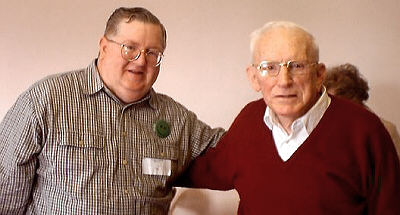
Shown in the photo are the speaker at the March meeting, Tom O'Leary (left), and longtime NAWCC and Ch. 148 member Dana Blackwell (right).
Tom's presentation was entitled "Imitations of 18-Size American Watches: Swiss Fakes". He began by explaining that Swiss imitations of American watches, typically (but not always) keywinders, were imported in great numbers between 1857 and approximately 1880. Some named examples include watches labeled "Wallingford Watch Company", "Meriden Watch Company", and "Bristol Watch Company".
Tom described the experience of the many collectors who either own or have owned one of these imitations. Something about the watch is troubling. A name is misspelled; expected information is missing regarding the name of the model or the place of origin. Consequently, the collector may begin to regard his acquisition with suspicion and even chagrin.
It is important to note that the quality of the Swiss imitations was generally equal to and sometimes even better than the American watches for whom they afforded competition. They fit flawlessly into American cases, but had very good quality cases of their own. Furthermore, the prevalence of these imitations led to federal legislation requiring railroad watches to be manufactured exclusively in the U.S. Tom advocates an appreciation for their not inconsiderable, affordable charm!
A talented and resourceful researcher, some of Tom's favorite sources for information include manufacturers' association trade catalogs, historical societies, tag sales and antique shops. We suspect the past twenty-two years of watch collecting have been terrific fun!
For those who would like to learn more about watch collecting, Tom recommends the Complete Price Guide to Watches, 21st edition, by Tom Engle, C. Shugart and E. Richard Gilbert (ed.) as one of the best resources. Published annually, it is a great asset to collectors of all experience levels. It contains comprehensive current information, photographs, history and identification tips on over 10,000 watches.
Thanks is due to Tom O'Leary, Walter Weber and Stan Dapkus for their kind assistance in the preparation of this article.
* * *
Meeting Highlights - January 20, 2001
by Mary Jane Dapkus
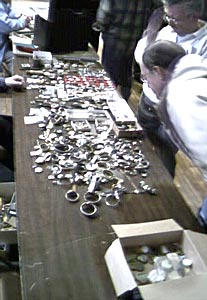 |
A few dozen hearty members of Connecticut Chapter 148 converged upon the Edmond Town Hall early Saturday morning, January 20, 2001, under lead grey skies heavy with the promise of impending snow. Those adventurous souls who arrived despite the less than ideal forecast were met with warmth and the pleasure of stimulating conversation. Mart table activity was reported to be sufficient to please most buyers and sellers. Our January meeting traditionally does not include a technical presentation, this one not excepted. At the appointed time, members gathered around President Jim Katzin, perched in his customary vantage point at the top of the gymnasium stairs, to hear his summary of chapter business, including plans and directions for the new year. Jim began by presenting a gift to Ethel Weber, through whose thoughtful ministrations we have enjoyed great refreshments at our meetings. Thank you, Ethel! |
Next Jim called for volunteers to assist with the upcoming tri-chapter celebration of the opening of the Timexpo Museum in Waterbury, scheduled for Saturday, May 12, 2001, from 9 A.M. to 4 P.M. The museum is located just off of I-84 adjacent to the Brass Mill Mall in Waterbury; parking is free. (For more information or to register, see flier posted at URL http://clockcollecting.com.) Volunteers are needed to perform a number of tasks on and before the day of the event, including setting up of over one hundred mart tables on Friday evening. There are volunteer opportunities to fit every schedule. Please contact Jim at or before our March meeting! Visit the Timexpo Museum web site.
Members are urged to contact Jim with ideas for speakers and presentations for the coming year. John Salva has gamely volunteered to assist the author in cataloging clocks and watches found in collections of local historical societies in CT. That's a lot of ground for two of us to cover: please consider sharing a little of your time and expertise with us on this project. The undertaking is a great opportunity to examine clocks, learn and perhaps share some exciting discoveries and adventures.
Happily, the storm delayed its appearance until the last of us had departed for home.
